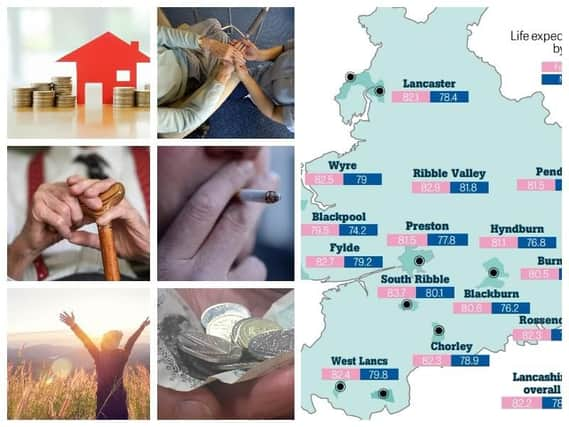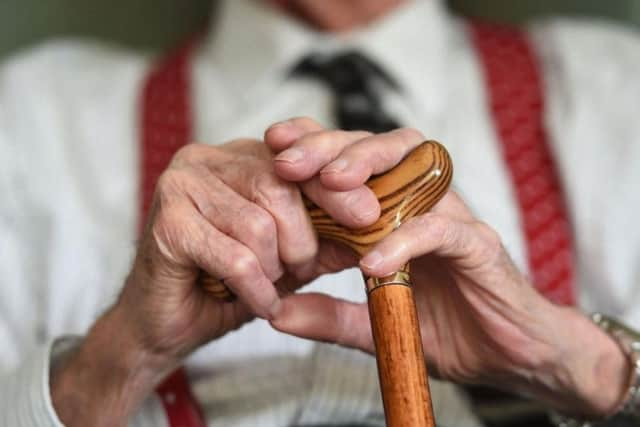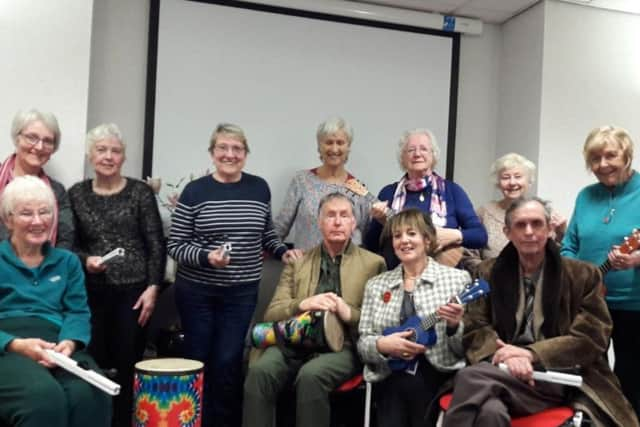LIFE EXPECTANCY: Find out how long you can expect to live in these parts of Lancashire


A significant number of Lancashire districts fall below the national life expectancy of 83.1 years for women and 79.5 years for men.
Lancashire County Council’s health scrutiny committee is now working on a strategy to improve wellbeing and iron out inequalities.
Advertisement
Hide AdAdvertisement
Hide AdThe district with the highest life expectancy is Broad Oak in Penwortham, where women can expect to live to 91.2 years.


By contrast in Queensgate ward, Burnley, women live to 72.1.
Male life expectancy ranges from 87.6 years in the South Ribble ward of Buckshaw and Worden to just 70.8 years in Hyndburn’s Central ward.
Coun Peter Britcliffe, (centre, below) chairman of LCC’s health scrutiny committee, said: “It’s quite shocking that there is this wide disparity in life expectations and something does really need to be done to address that problem.”
Advertisement
Hide AdAdvertisement
Hide AdA report to councillors noted age, sex and hereditary factors are set, but improving health and other services contributes enormously to a person’s health.


The report defines health inequalities as “systematic, avoidable and unjust differences” in health and wellbeing. And it concluded that action is needed “across communities, public, private and voluntary, community and faith sectors, and national government” to improve Lancastrians’ health and lifespans.
Research has shown clinical care will determine 20 per cent of an individual’s health, but other key factors – behaviour, socioeconomic factors, income level, education, housing, and the support and friendships of community networks together have a great impact.
Morecambe councillor Stuart Morris pointed out that Lancashire’s industrial legacy from mills and mining might impact on longevity figures.
Advertisement
Hide AdAdvertisement
Hide AdHe added that young people had gone from having two hours of exercise a day to two hours a week.


He said: “Children are too sedentary, too hooked into computers. They would be much better playing outside.”
County Coun Steve Holgate (left) said: “We are what we eat, we are what we do. There are a lot of determinants – where you live and the type of housing you live in obviously makes a difference.”
Lancaster Green Coun Gina Dowding (far left) pleaded for “active travel”, cutting car use and encouraging walking and cycling.
She said: “We need to facilitate a safe environment.


Advertisement
Hide AdAdvertisement
Hide Ad“I feel we need to be far more radical as a public health department.
“We have huge differences in life expectation and healthy life expectancy and we need to be worried.”
Councillors agreed to support the Healthier Lancashire and South Cumbria Sustainability and Transformation Partnership in its work to improve life expectancy in districts and wards across the county,
The committee also voted to draw up recommendations on working with district councils and partners to improve life expectancy and have a “health in all policies” approach – particularly on planning and economic issues; get advice from public health specialists on how to effectively embed health in all policies so that changes are made.
Advertisement
Hide AdAdvertisement
Hide AdIt also agreed to support, champion, and improve access to high quality healthcare wherever people live; support work to cut unfair variations in access to and quality of care and health outcomes; and work to help communities and individuals improve their health and wellbeing.
‘Fair access to healthy food and open spaces’
County Coun Joan Burrows, Lancashire’s Champion for Older People is keen to share good practice to ensure all Lancastrians enjoy a longer and healthier older age.
But as Penwortham councillor she had a particular interest in the news that the town’s Broad Oak ward has gained distinction as the ward where women live longest to the age of 92.
Coun Burrows, who represents Penwortham East and Walton-le-Dale, said: “Obviously it backs up a report from a couple of years ago which said that South Ribble is the best place to live!”
Advertisement
Hide AdAdvertisement
Hide AdShe speculated that the Broad Oak bonus could be down to people having access to facilities such as a library and open spaces, good food shops, fewer takeaways and leisure facilities as well as reflecting past incomes.
As a member of the Health Scrutiny Committee, she says she is keen to ensure other areas have the same benefits and said: “I want to see a fairer access to healthy food and to ensure people can make use of the open spaces.”
As part of her role, she has visited the Singing For Wellbeing group, which provides a musical and social group for older people.
The Chorley group was set up by Life Long Song social enterprise founders Janet Wright and Alison Maze, with the aid of funding from the Allen Lane Foundation.
Advertisement
Hide AdAdvertisement
Hide AdIt meets on Tuesdays at Galloway’s Centre on Farrington Street, Chorley, from 1.30pm-3pm. Janet said group members say how good the song
sessions make them feel: “One 90 year old lady said, ‘I love being with these people’. It gets people out but it’s also creative. It’s a lovely group and they are very welcoming.”
Breakdown by gender
FEMALE
St Matthew’s and Moor Park wards in Preston had the lowest female life expectancy at 77, followed by Ribbleton at 78, University ward at 79, Ingol, Fishwick, St George’s and Garrison at 80, Riversway, College and Brookfield at 81, Town Centre and Deepdale at 82, Sharoe Green, Cadley, Tulketh and Larches were 83, Lea 85, while Preston Rural North and Preston Rural East were 86. Greyfriars ward topped the list at 88.
MALE
Ribbleton ward in Preston had the lowest male life expectancy in Preston at 72, followed by St Matthew’s and Town Centre at 74, St George’s, Fishwick and Riversway at 75, Ingol and Larches at 76, followed by Moor Park and University at 77 while Garrison, Ashton, Brookfield, Deepdale, College, Lea and Sharoe Green were 79, followed by Tulketh and Cadley at 80, Preston Rural North at 81, Preston Rural East at 82 and Greyfriars at 84.
Advertisement
Hide AdAdvertisement
Hide AdIn Preston, Chorley and six other districts – Lancaster, West Lancashire, Burnley, Hyndburn, Pendle and Rossendale - female life expectancy is significantly lower than the English average of 83.1 years.
In Preston and five other districts – Lancaster, Burnley, Hyndburn, Pendle and Rossendale – male life expectancy is significantly lower than the English average of 79.5 years.
Lancashire’s average female life expectancy is 82.2 years, but only 77.2 per cent of that life – just 63.4 years – will be in good health.For men the average life expectancy in Lancashire is 78.7 years and just 62.5 years will be in good health.
Between 2005-7 and 2014-16, life expectancy in the county council’s 12 districts increased in line with national trends but now the rate of increase appears to be slowing down – again in line with national trends.